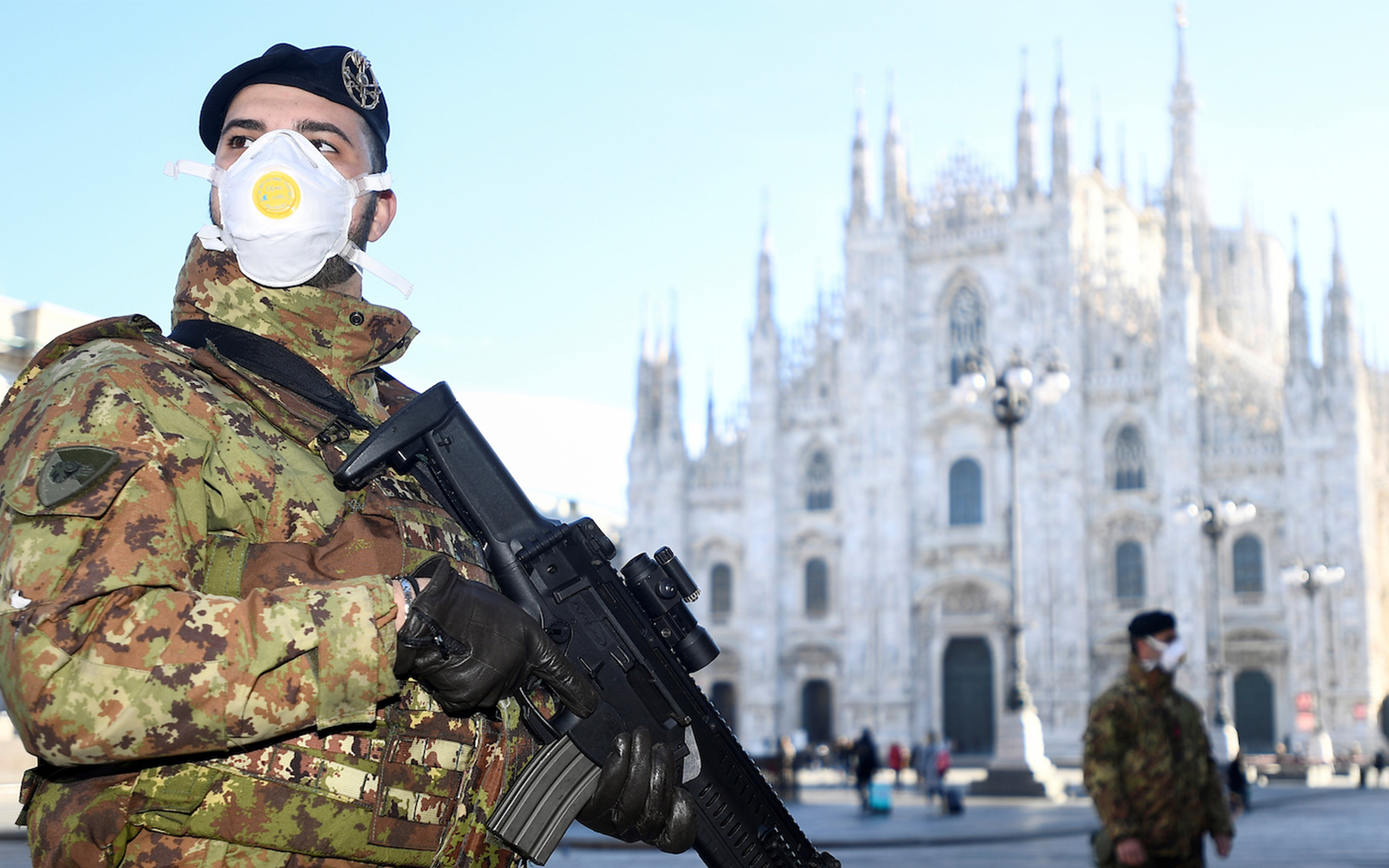Italy has become one of the most affected countries by the Covid-19 pandemic. This situation led to the discussion of the adequacy of measures taken by the government to handle the coronavirus outbreak. This article tries to look at the governmental response to the pandemic through the lenses of the securitization theory. It argues that although the effectiveness of the measures taken can be questioned, the securitizing narratives employed by the governmental officials helped them convince the public of the necessity of the measures and accumulate public support at the early stages of the pandemic.
Introduction
Italy has become one of the most affected countries since the beginning of the novel coronavirus outbreak. Even on 28 November 2020, Italy was the fourth country in the world by the number of cases and fifth by the number of deaths (Johns Hopkins Coronavirus Resource Center, 2020). According to some scholars, the high lethality rates during the first “wave” can be explained by the high number of elderly people in Italy (Oke & Heneghan, 2020) or be a consequence of insufficient testing, which led to a misleading share of deaths in the total number of cases (Villa, 2020). Nevertheless, the significant amount of cases and deaths posed a question about the adequacy of the measures the government took.
This article will focus on how the Italian government responded to the pandemic from 31 January 2020, when the Italian government proclaimed a state of emergency (Governo Italiano, 2020b), to the end of March when the national lockdown was prolonged (DL 25 marzo 2020, n. 19). It aims to evaluate the reaction of Italian authorities at the early stages of the pandemic and consequences of this policy for the government, looking at the development of the situation through lenses of securitization theory.
This author argues that although the governmental response to the coronavirus pandemic was not flawless, the steady securitization of the issue and convincing the population of the necessity of the measures helped the government and the prime-minister Giuseppe Conte itself increase public support at the early stages of the spread of Covid-19 in Italy. Thus, the governmental strategy failed to prevent the spread of Covid-19, but it gave the political institutions and officials (specifically, the Prime Minister Giuseppe Conte) public support.
Thus, in the beginning, there will be a short overview of the securitization theory. In the next part, the several stages of securitization of the issue in Italy and their outcomes will be discussed. In the end, the findings will be summarized.
Securitization theory
In recent years, some of the global health concerns have become an object of security. Such problems as HIV/AIDS and the global spread of infectious diseases were framed as global security issues (Rushton, 2011). The current outbreak of novel coronavirus was characterized as an international public health emergency on 30 January 2020 and as a pandemic on 11 March 2020 (WHO, 2020), therefore, it also became a matter of security.
To analyze how the outbreak of the novel coronavirus was securitized in Italy, the approach of the Copenhagen School will be adopted. According to scholars usually associated with this school (Buzan et. al., 1998), the process of securitization has several important elements. First of all, they emphasize the role of the speech act. Thus, an issue becomes a matter of security while a securitizing actor declares this issue as such. However, the speech act is necessary but not sufficient for a successful securitization. An audience decides if this securitizing move (attempt of a securitizing actor to securitize an issue) will be successful or not. Although Buzan and Waever do not specify this aspect of their theory, and for this they are usually criticized (McDonald, 2008), it does not seem an insurmountable problem for the application of this theory. This essay will assume that the public accepted the securitizing move when about half of a population perceived something as a threat. To capture changes in the public perception of coronavirus as a threat the results of survey will be used in this essay. After the audience has accepted the securitizing move, a securitizing actor receives extraordinary powers to resolve the issue (Buzan et. al., 1998).
Besides, for the analysis, one should understand two other concepts: who is a referent subject and referent object. According to Copenhagen school scholars (Buzan et. al., 1998), the former is who/ what poses a threat, and the latter is who/what is threatened. It is crucial for this analysis because this essay argues that although a referent subject remained the same (Covid-19), a referent object changed over time in Italy, which allowed the authorities to take more severe measures to limit the liberties of citizens.
Securitization of Covid-19 in Italy
In this part, the reaction of the Italian government to this situation will be discussed in terms of narratives they used to frame and securitize the issue, and concrete steps to deal with the outbreak. Thus, the essay will discuss the speeches of the Italian Prime Minister, Giuseppe Conte, and its Minister of Health, Roberto Speranza. The narratives of the most influential opposition party, the League, will be beyond this investigation because although their leader wanted to challenge the governmental response to the emergency (The Brookings Institution, 2020), his narratives were not accepted by the audience. Italians considered his attacks against the government in that time inappropriate (La7.it, 2020a). Moreover, personal rating and the rating of his party declined in this period (Sano, 2020; Demopolis, 2020). Thus, it could not significantly challenge the governmental narratives.
Stages of securitization
The process of securitization of Covid-19 in Italy can be divided into several stages. At every stage, narratives and public reaction to them will be outlined as well as measures taken by the government.
- 30 January 2020 – 20 February 2020 – first securitizing move
At the beginning of the outbreak, a few measures were imposed. They coincided with the announcement on 30 January of a health emergency of international concern by WHO and confirmation of two cases of Covid-19 in Italy (Istituto Superiore di Sanita, 2020). Thus, all flights between Italy and China were suspended, and on 31 January, the Italian government declared a state of emergency for six months (Governo Italiano, 2020b). Several narratives discussed below accompanied these measures.
Do not panic
Right after the declaration of a state of national emergency on 31 January, governmental officials tried to downplay the effect of this act. One of the narratives that they used to do it is “do not panic, we control everything”. For example, on 31 January, Speranza told citizens that the “situation is under control”, “Italy should not be afraid”, “no alarmism” (Guerzoni, 2020). The Prime Minister also contributed to attempts for “reassurance” of the public saying that “there is absolutely no reason to arouse, to create alarm or to spread social panic” (Dire.it, 2020).
Italy as a strong and safe state
Since the very beginning of the outbreak, the government tried to create an image of Italy as a strong state that tackles the coronavirus seriously and better than other countries. Before the declaration of the state of national emergency, Speranza pointed out that “among Western countries, Italy is the best equipped and the most attentive” and added “out of the 3 European countries … which had direct flights from Wuhan, only Italy carried out preventive checks. Our country immediately planned control measures” (Rizzuti, 2020). On 31 January, Speranza said that “Italy is a large and strong state” and its healthcare system is “strong” and “capable” to deal with this issue (Guerzoni, 2020).
Although such claims can be considered as securitizing moves because make people aware that something very serious is happening in the country, they were the only one taken by the government until 21 February. It seems that the absence of this topic for such a long time made people less prone to perceive the outbreak as a threat. According to Ipsos editor (2020a), on 13 February, only 12% of Italians perceived Covid-19 as a threat to themselves and their community, 24% – to the state. Thus, this first securitization move failed – coronavirus was not perceived as a threat.
- 21 February 2020 – 29 February2020 – securitization (referent object – state)
Another set of restrictions were imposed after several outbreaks across the northern part of Italy were registered. Since this time, the number of cases was in constant increase along with the death rate until the second half of March. On 21 February, the Ministry of Health introduced mandatory quarantine for 14 days for those who contacted a person with a positive coronavirus test (Ministero della Salute, 2020). Then on 23 February, Conte approved a decree that introduced restrictions for movements and social gatherings in municipalities where at least one case was confirmed (DL 23 febbraio 2020, n. 6). On 25 February, a new decree suspended all sports events in several regions, all educational trips and exchanges (Dpcm 23 febbraio 2020). These measures were accompanied by another set of narratives.
Covid-19 as a national emergency, challenge
Although the “state of national emergency” was declared on 31 January, the word “emergency” (Il Messaggero, 2020) entered the discourse of Prime Minister only after 22 February. He repeated it twice, pointing out that he was in touch with governors of Lombardy and Veneto, where a day before several cases had been confirmed.
Do not Panic
Besides, Conte also asked his people “to chase away any social alarmism, any panic” on 21 February. He said that citizens “should trust” him because they base their decisions on the statements of a technical-scientific committee (Agenzia ANSA, 2020). Thus, transferring the responsibility for potentially unpopular measures to scientists, he tried to keep the way out open if measures will be considered too extreme.
Unity
One of the main themes in governmental rhetoric was the notion of the necessity of unity between political forces, and between people. On 23 February, Conte said that “in the face of the emergency, there is no distinction between the majority and the opposition” and “regarding the health of citizens, there must be no distinction of political colors” (La Repubblica, 2020). Speranza, in his turn, highlighted that “there is no one person alone.. the state as a whole is doing its part” (La Repubblica, 2020), drawing attention to the unity not only between politicians but also between politicians and the public. Moreover, on 26 February, Conte suggested “three ethical imperatives: collaborate, collaborate, collaborate” for the times of the Covid-19 spread, adding that they will call all country’s forces together for that (Rai News, 2020). Thus, the government was concerned to persuade in the necessity of measures primarily their political opponents and then public because the state as a political entity is threatened.
Italy as a strong and safe state
In other times Conte stepped in claiming that “Italy is a safe country.. maybe, it is safer than many other (countries)” on 26 February (Rai News, 2020). Moreover, he repeated the words of his minister by saying that the Italian “healthcare system is among the most efficient in the world” (Rai News, 2020). Moreover, calling for unity he said that they “will demonstrate to the world that Italy can emerge from an emergency with its head held high” (Rai News, 2020). Thus, he highlighted that this outbreak is an issue of the country, which is able to deal with it.
In sum, narratives created a sense that the outbreak is not an ordinary issue, but something serious (emergency) that should be combated by the united country. Thus, the referent object was the state. These narratives accompanied or preceded new restrictions. At the same time, the public accepted this move. Thus, although preoccupations about themselves (23%) and communities (28%) remained relatively low, preoccupations about the state were shared by almost half (46%) of the Italian population (Ipsos editor, 2020b). It allowed authorities not to face any mass protests against restrictions, which they could have faced in another situation. Moreover, right after the government had adopted the first measures, 86% of Italians considered them as just (La7.it, 2020a). Thus, securitization (with a referent object – state) was completed. However, it remained for the majority a threat, not to themselves or their community, which could have created problems if the Italian government had decided to impose more restrictions at this time. Thus, for further securitization, a securitizing object should have been changed.
- 01 March 2020 – 19 March 2020 – securitization (referent object – community)
On 1 March, nonessential activities were suspended in some municipalities, new restrictions concerning social gatherings were established in other provinces of Lombardy, Emilia-Romagna, Veneto and provinces Savona and Pesaro e Urbino, also some preventive measures (information campaigns and isolation) were introduced throughout the national territory (Dpcm 1 marzo 2020). Since 5 March, activities of all educational institutions were suspended (Governo Italiano, 2020b). On 8 March, all gatherings in public places or open to the public were forbidden in some regions (Dpcm 8 marzo 2020), but on 9 March, these restrictions were extended to the whole territory of the state from 10 March to 3 April (Dpcm 9 marzo 2020). Thus, the government imposed a national lockdown. These restrictions required some changes in rhetoric.
Covid-19 as a national emergency, challenge
On 8 March, the rhetoric towards Covid-19 strengthened – Conte called it an “epochal emergency”, “an emergency with which Italy, at least in its most recent history, has never faced” (Cappellini, 2020). Thus, the severity of the situation and its extremely extraordinary character were highlighted.
Unity
On 4 March, the rhetoric was strengthened by the phrase “It is not the first time that our country has faced national emergencies”, “we are… a country that does not give up: it is in our DNA” (Governo Italiano, 2020a). Conte also used such phrases like “it is a challenge that must be won with everyone’s commitment”, “We‘re on the same boat”, “We must continue to work together towards a common goal” (Governo Italiano, 2020a). On 8 March, the Prime Minister emphasized the importance of everyone’s action towards resolution of the problem, that “people, public” are us” (Cappellini, 2020). Saying this, Conte emphasized the fact that the challenge requires citizens as a community to be strong. He emphasized the fact that it is a problem of a state as a community of people, not only as a political entity.
At this stage, one can observe a sharp increase in perception of Covid-19 as a threat. Thus, on 12 March, 48% of the population in Italy perceived it as a threat to themselves, 62% – to their community, 82% – to the state (Ipsos editor, 2020b). Moreover, On 4 March 2020, 65% of Italians said that they are satisfied with how the government deals with the emergency, and 61% of Italians began to feel securer after the adoption of decrees that limit their movements (La7.it, 2020b). Thus, securitization (with the referent object – community) was completed. The public (the audience) perceived the outbreak of Covid-19 as a threat to themselves and those who are close to them. Thus, people were ready to accept the full national lockdown and sacrifice their liberties in exchange for being in security.
- End of March 2020 – further development of narratives (Covid-19 as a threat to your life)
On 20 March, the Ministry of Health introduced further measures that forbade access to parks, public gardens, play areas. Besides, outdoor activities were allowed only near one’s home and on an individual basis (Ordinanza 20 marzo 2020). On 22 March, the Ministry of Health forbade movements using any transport means in another municipality if there is not an urgent necessity to do it (Ordinanza 22 marzo 2020). On the same date, the Prime Minister signed a decree according to which all productive activities that are not strategic or essential should be closed (Dpcm 22 marzo 2020). The decree, adopted on 24 March by the government, contained measures to combat coronavirus and stated that they can be applied to parts of Italy or the whole territory for a certain period, but not more than 30 days (DL 25 marzo 2020, n. 19). This prolongation of the lockdown and tightening of restrictions could not have been accepted without justification of their necessity.
Covid-19 as a national emergency, challenge
On 21 March, Conte called Covid-19 “the most difficult crisis” after the Second World War. Besides, he called those days “hard” and used the phrase “We do not have alternatives” to justify “severe measures” and asking for a “sacrifice” of staying at home from his people (Sodano, 2020). Thus, he repeated that this situation is not a problem of someone else or a government, but it is a matter of concern for everyone. Even more importantly, he stated that there is not another way out of the situation, therefore, any measures should be accepted.
Unity
On 21 March, Conte once again emphasized the importance of unity and collective actions, claiming that “community must tighten as a chain to protect the most important asset – life” (Sodano, 2020). Thus, repeating that this situation concerns each citizen, his/her own life.
The rhetoric on this stage was the most alarmist since the beginning of the outbreak. Thus, the survival of the population became at stake. It is not a surprise that in the period between 19 March and 16 April perception of Covid-19 as a threat remained high. It fluctuated from 52 to 54% for Italians themselves, 67-73% for their community, 86-88% for the state (Ipsos editor, 2020b). Although it could not contribute to once more securitization of the issue, it justified the prolongation of extraordinary powers by the government. Then one can observe a decline in this indicator (Ipsos editor, 2020b), which coincided with the announcement of easing restrictions from a certain point of time made on 26 April by the Prime Minister (The Local, 2020).
Outcomes of the Italian government’s strategy to handle the pandemic
The results of the strategy of the Italian government to deal with the coronavirus pandemic can be assessed from two major perspectives: the political perspective and the crisis-management one.
From the political perspective, the government succeeded to gain some benefits from the situation by employing the securitization approach to handle the spread of the coronavirus. The trust in institutions increased (Falcone et. al., 2020) and, specifically, in Prime Minister from 40% in January to 60% in April (Demopolis, 2020). Thus, although the numbers of cases and deaths were among the highest in Europe and the government took measures not to prevent the Covid-19’ spread, but in response to it, the public support of the institutions not only did not decrease but significantly increased. This shows us that from the political point of view securitizing approach was the right one to employ at the time.
From the point of view of crisis management, the government remained reluctant to take preventive measures. Thus, as we saw before, after the declaration of the state of emergency the government did not do anything before the number of cases significantly increased. This responsive approach could not prevent the spread of coronavirus in Italy and, therefore, Italy found itself among the countries with the highest numbers of cases in Europe and the world. Besides, the government failed to establish good coordination with regions on the management of the spread of the pandemic. The most illustrative example of this failure can be the decision of the Marche regional government to close schools in February, which was criticized by the central authorities (La Gazzetta del Mezzogiorno.it, 2020). Thus, crisis management was not as effective as it could be.
Thus, although politicians accumulated high public support by using securitizing narratives, their crisis-management strategy did not prove to be effective. The responsive character of the anti-covid policy and steady measures, which helped the government to securitize the issue at different levels and did not provoke public unrests, were not helpful to prevent the spread of coronavirus and the deaths of the populations.
Conclusion
Italy has been one of the countries that suffered and continue to suffer the most in the world. The first cases were confirmed at the end of January and the state of emergency was declared by the government, but there were no severe restrictions imposed. Thus, although attempts to “reassure” the public that it should not panic can be considered as the first securitizing move, the public did not accept it.
Only at the end of February, when several cases were registered in the northern regions of Italy, the rhetoric of the government began tougher to the pandemic. It began to create several narratives that should have helped it to securitize the situation and impose restrictions. However, the referent object for these attempts was the state, which allowed it to introduce only a limited number of restrictions. At this stage, the public accepted this securitizing move but did not perceive Covid-19 as a threat to themselves or their community.
At the beginning of March, things changed. Officials tried to convince citizens that they as a community are threatened. Moreover, they emphasized that is not an ordinary challenge, but something that the community faced first time in many years; therefore, it requires extraordinary measures. The public accepted this move fully. The number of people who perceive a coronavirus as a threat to themselves approximately doubled, which paved the way to announce a national lockdown. Further development of the narratives was necessary to prolong the measures and extend the extraordinary powers of the government. The audience accepted this as well.
Taking all these into account, although steps that the Italian government took to combat the outbreak can be considered as late and insufficient in the early stages of the development of the situation, from a political point of view, it was an adequate policy. Being a democratic state Italy could not impose severe restrictions on its citizens without a deliberation process. Although the latter took time, it allowed the government to persuade citizens in the necessity of restrictions and helped it to save and even increase public trust and support. However, the adequacy of this strategy can be questioned from the point of view of crisis-management, taking into account the fact that preventive measure could have helped the government to stop the spread of the Covid-19 in the country.





